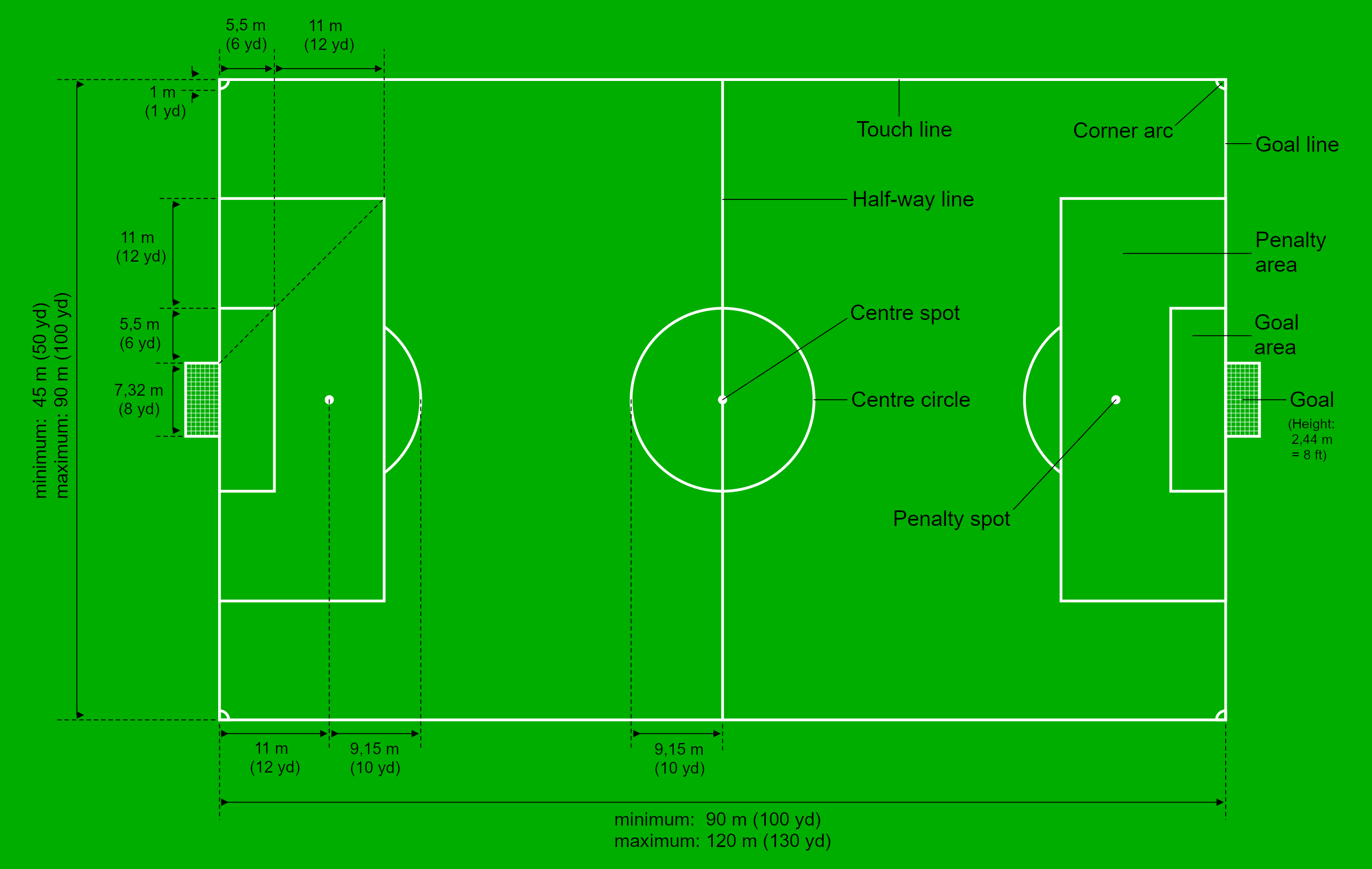A soccer field, or pitch, is a rectangular play area with specific markings for gameplay. It consists of a midline, a center circle, penalty areas, and goal areas.
Understanding the layout of a soccer field is crucial for players, coaches, and fans alike. The field varies in size, but for professional matches, it generally measures between 100-130 yards in length and 50-100 yards in width. Clearly, demarcated lines outline the boundaries, with a halfway line cutting across the center, connecting the midpoints of the two longer touchlines.
The center circle, with a radius of 10 yards, signals the spot for kick-offs. Each end of the pitch contains a goal area and a penalty area, essential for set plays and determining fouls. The layout ensures a standardized playing environment, contributing to the fairness and consistency of the game across different venues worldwide. Mastery of the field’s dimensions and areas can give teams a strategic advantage during play, underscoring the importance of this foundational knowledge.
The Origin Of Soccer Field Design
The origin of soccer field design tells a captivating tale, dating back over a century. From makeshift play areas to meticulously measured pitches, the evolution of the soccer field mirrors the growth of the sport itself.
Early Days Of Soccer
In the early days, soccer didn’t have formal fields. Games took place on any open space big enough for teams to compete. These early playgrounds varied greatly in size and shape, with no two soccer fields alike. Markings were often missing, making it hard to judge boundaries and goals. Local traditions dictated the rules, leading to diverse play styles across regions.
Evolving Regulations And Designs
As soccer’s popularity surged, the need for standardization became clear. In 1863, the Football Association in England released the first comprehensive set of rules. This crucial step included specifications for pitch dimensions and markings. Over time, the Fédération Internationale de Football Association (FIFA) took over the task of refining these regulations.
Today’s soccer fields display common features thanks to standardized regulations:
- Rectangular shape with specific length and width
- Two long touchlines and shorter goal lines
- Center circle for kick-offs
- Penalty areas for each goal
A well-defined layout aids players, coaches, referees, and fans alike.

Dimensions And Markings
The beautiful game of soccer requires a pitch, or field, with specific dimensions and markings. These regulatory features ensure that the game remains fair, competitive, and standardized across the world. Let’s delve into the sizes and lines that define a soccer field, making sense of every chalked boundary and numeric figure that shapes the game.
Regulatory Size Ranges
A soccer field’s size can vary depending on the level of play. From children’s leagues to professional matches, the pitch size adjusts but falls within accepted size ranges. Here are the key numbers that keep the game standardized:
| Field Component | Minimum Size (meters) | Maximum Size (meters) |
|---|---|---|
| Length | 90 | 120 |
| Width | 45 | 90 |
For international matches, stricter limits apply. Length varies from 100 to 110 meters, while width ranges between 64 and 75 meters.
Line Markings And Their Meanings
A soccer field isn’t complete without its iconic markings. Each line carries a unique purpose during play:
- Touchlines: These are the longest lines that run the length of the field.
- Goal lines: Lines found at the end of the field mark the goal area.
- Midfield line: Divides the field into two halves.
- The Penalty Area: Includes the goal, the penalty spot, and is where goalkeepers can handle the ball.
- The Center Circle: Dictates kickoff procedures and maintains player distance.
- Corners: Marked by quarter circles at the field corners for corner kicks.
Every line and marking serves to guide the game with clear boundaries and zones. Understanding these ground rules is crucial for players, coaches, and fans alike.
The Pitch Surface
The soccer field, or the pitch, is more than just a playing area. It is the canvas where the art of the game unfolds. The type of surface on which the game is played impacts players’ performance and the game’s pace. From grass to synthetic turf, various options exist, each with unique characteristics. Let’s dive into the details of these surfaces and understand the maintenance they require.
Grass Vs Synthetic Turf
Choosing the right pitch surface is crucial for the game’s quality. Each material comes with pros and cons that affect playability.
| Grass | Synthetic Turf |
|---|---|
| Natural feel, preferred by players | Consistent quality, all-weather usage |
| Requires sunlight and water | Less water, no sunlight needed |
| More maintenance, can get muddy | Easier upkeep, no mud issues |
Maintenance Best Practices
Maintenance is key for a pitch to remain in top condition year-round. Follow these best practices to ensure peak performance:
- Regular Mowing: Keep grass height even for fair play.
- Aeration: Prevent soil compaction, ensuring heath of the turf.
- Irrigation: Hydrate adequately but avoid waterlogging.
- Fertilization: Nutrient-rich soil fosters healthy grass growth.
- Repair: Promptly address wear and tear, especially in high-use areas.
For synthetic pitches, routine brushing and infill leveling are imperative. Also, sanitize to prevent bacteria buildup.

Goal Area And Penalty Box
Understanding the Goal Area and Penalty Box is crucial in soccer. These sections of the pitch play a vital role during the game. Whether it’s a thrilling save by the goalkeeper or a nail-biting penalty kick, the action revolves around these marked zones.
Precise Measurements
The goal area, also known as the six-yard box, encompasses the space where goal kicks are taken. Key dimensions for the goal area are:
- 6 feet (1.83 meters) from each goalpost
- 6 feet (1.83 meters) out from the goal line
The penalty box is larger and holds greater significance. It is marked as:
- 18 feet (5.5 meters) from the inside of each goalpost
- 18 feet (5.5 meters) out from the goal line
| Area | Width | Depth |
|---|---|---|
| Goal Area | 6 yd (5.5m) | 6 yd (5.5m) |
| Penalty Box | 18 yd (16.5m) | 18 yd (16.5m) |
Fouls And Consequences
A foul in the penalty box often leads to a penalty kick. Here’s what happens:
- A direct kick against the defending team
- An opportunity for the attacking team to score
- A one-on-one situation with the goalkeeper
Goalkeepers must also follow rules within the goal area:
- They cannot hold the ball for more than 6 seconds
- Avoiding back-passes
- Maintaining sportsmanlike conduct
Outlining these areas correctly is essential. It ensures that the game stays fair and exciting. Players and referees must both respect these boundaries.
The Center Circle And Kick-off Spot
The Center Circle and Kick-off Spot are crucial parts of a soccer field. Each element plays a specific role. Together, they signal the start of an exciting soccer match. Their design is not just for formality but carved out of tradition and functionality.
Role In Match Commencement
The kick-off marks the beginning and restart of the game. At both halves and after goals, teams gather here. Only the player taking the kick-off is allowed inside the Center Circle at this time. All other players must be outside the circle. This rule ensures a fair start or restart of play.
Symbolism And Structure
The Center Circle is a symbol of unity and fair play, where no team has an advantage at the start. This 9.15 meters radius circle ensures opponents are at a set distance during kick-offs. The kick-off spot stands at the heart of the circle.
| Feature | Function |
|---|---|
| Center Circle | Marks the space for restarts |
| Kick-off Spot | Starting point for the ball |
- Diameter: 18.30 meters
- Radius: 9.15 meters
- Location: Midfield
This central area is where soccer’s most thrilling moments begin. The Center Circle and Kick-off Spot set the stage for a contest filled with energy and anticipation.
Corner Areas And Flag Posts
When the ball goes out over the goal line, corner areas spring into action. Here, games can turn with a single kick. Each corner holds a flag post, marking the spot where corner kicks take place. These moments are crucial in soccer and need clear rules.
Corner Kick Dynamics
Kickers get the chance to put the ball back into play from the corner area. They must place the ball inside the corner arc. All other players stay out of this arc until the ball is in motion.
- A direct goal can be scored from a corner kick.
- Defenders must stay at least 9.15 meters away until the ball moves.
- The ball is in play once it’s kicked and moves.
Specifications Of Flag Posts
Every corner of the field sports a flag post. They stand at least 1.5 meters high. A post must be planted outside the playing field. Each flag post helps the referee judge the ball out of bounds.
| Characteristic | Specification |
|---|---|
| Height | Minimum 1.5 meters |
| Position | At each corner |
| Outside Field | Yes |
| Safety | No sharp edges |
Technical Areas And Team Benches
Understanding the soccer field layout involves more than just the playing area. The technical areas and team benches play a pivotal role during a match. They are special spots where coaches and substitutes stay. These areas help maintain order during the intensity of the game. Let’s dive into the specifics of these crucial zones on a soccer sideline.
Coaching Zone Limits
Each soccer field features a clearly marked technical area. This space defines where coaching staff and substitutes can be during the game. The rules are strict.
- Size: Typically, it extends 1 meter on either side of the team benches and up to 1 meter from the touchline.
- Boundary: A marked box, it ensures coaches don’t roam too far.
Seating Arrangements And Regulations
Team benches are not just seats. They follow certain guidelines to ensure fairness and safety.
| Aspect | Regulation |
|---|---|
| Location | They are situated within the technical area, mostly aligned with the center line. |
| Capacity | Designed to seat substitutes, coaches, and staff—usually up to 23 people. |
| Restriction | Only authorized personnel can sit on the benches during a match. |
The right setup in these areas helps teams focus on strategies without distractions.
Stadium Critical Features
The heartbeat of any soccer match doesn’t solely lie with the players on the field but also resonates through the very structure of the stadium itself. Stadiums are more than just fields surrounded by seats; they are architectural marvels, meticulously designed to enhance the experience of every spectator and player. Let’s dive into the critical features that define a soccer stadium’s allure and functionality.
Spectator Accommodations
A soccer stadium thrives on the energy of its fans, making comfortable and accessible seating vital. Modern stadiums are equipped with a variety of seating arrangements, from general admission to VIP boxes, ensuring a perfect view for every fan. Features include:
- Ample legroom for comfort
- Convenient access to restrooms and concessions
- Clear signage for easy navigation
- Seats designed to provide unobstructed views
- Disabled access ensuring inclusivity for all fans
Adequate emergency exits and safety measures are also integral to the design, keeping everyone safe while they enjoy the game.
Lighting And Scoreboards
Lighting and scoreboards play pivotal roles in both the gameplay and fan experience. High-quality lighting illuminates every inch of the pitch, creating a theatrical effect that keeps all eyes fixated on the action. This includes:
| Feature | Description |
|---|---|
| Eco-friendly LED lights | Reduce energy use and improve visibility |
| Strategic placement | Eliminates shadows and glare for players and spectators |
Scoreboards serve as the focal information hub, instantly updating fans with scores, player stats, and replays. Modern scoreboards feature:
- High-definition screens to keep everyone engaged
- Real-time updates that enhance the viewing experience
- Interactive elements, like social media feeds and fan cams
Innovations In Field Technology
Soccer fields have come a long way from just grass and white lines. Today’s fields are high-tech wonders. Clever gadgets and advanced systems work quietly under the green turf. They create perfect playing conditions. Let’s explore some of the coolest innovations keeping soccer fields at the top of their game.
Subsurface Cooling Systems
Beat the heat with what’s beneath your feet. Subsurface cooling systems are a game-changer. Soccer matches can get hot, especially in sunny regions. Now, imagine an underground system that keeps grass cool. Tiny pipes under the field circulate cold water. This drops the temperature. So, players enjoy cooler, firmer ground to play on.
- Pipes buried under the turf
- Water circulates, removing heat
- Even grass growth with less stress on turf
Smart Turf Advances
Turf that thinks? That’s right! We now have smart turf. Sensors and fibers mix with real grass. They monitor everything. Soil moisture, grass health, and even field hardness are checked. This artificial-natural blend means better play. It also makes the field last longer.
| Sensor Type | What It Does |
|---|---|
| Moisture | Checks soil water level |
| Fiber | Tracks grass blend strength |
| Hardness | Measures ground firmness |

Frequently Asked Questions On Soccer Field Layout
What Is The Standard Soccer Field Size?
The standard soccer field, also known as a pitch, measures between 100-130 yards long and 50-100 yards wide for professional adult matches. FIFA regulations suggest an optimal size of 110 by 70 yards for most matches.
Are Soccer Field Dimensions The Same For All Leagues?
No, field dimensions can vary. While FIFA provides guidelines for international matches, sizes may differ in youth, amateur, and some professional league games, with fields adjusted for the available space and age of the players.
What Are The Key Markings On A Soccer Field?
Key soccer field markings include the halfway line, penalty areas, goal boxes, center circle, corner arcs, and touchlines. These lines and areas define critical zones for gameplay, such as where goals can be scored and where goal kicks take place.
How Far Is The Penalty Spot From The Goal?
The penalty spot is 12 yards away from the goal line, situated within the penalty area. This distance is consistent across all soccer fields following the Laws of the Game as stipulated by FIFA.
Conclusion
Understanding the soccer field layout is crucial for players and fans alike. With this knowledge, you’re set to appreciate the game’s dynamics more fully. Embrace these insights as you watch or play, and let your newfound understanding enhance your love for the beautiful game.

